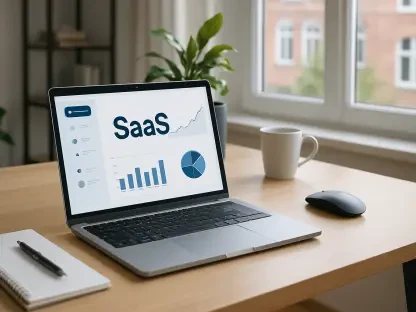In a digital landscape where attention is fragmented across countless apps and platforms, email has emerged as an unexpected yet powerful force transforming the Software-as-a-Service (SaaS) industry. Far beyond its traditional role as a communication tool, email is now the backbone of user engagement, operational efficiency, and strategic growth for modern SaaS companies. This shift, often termed the “email-first” approach, reimagines the inbox as a central hub where critical updates, actionable tasks, and personalized insights are delivered directly to users. With billions of emails exchanged daily, SaaS platforms are capitalizing on this universal touchpoint to meet users in a space they already frequent, thereby reducing friction and enhancing accessibility. This isn’t merely a passing trend but a fundamental redesign of how software interacts with its audience. As email takes center stage, it brings both remarkable opportunities and unique challenges, reshaping the way businesses connect, automate, and scale in today’s competitive environment.
The Email-First Approach in SaaS Design
Redefining User Engagement
Email-first design marks a significant departure from traditional SaaS models that rely heavily on in-app dashboards or notifications to keep users engaged. Instead, this innovative approach embeds core functionalities directly into the inbox, allowing users to interact with platforms without the hassle of logging into separate applications. Imagine receiving a project update, a billing alert, or even a task approval prompt right in an email, complete with clickable actions that resolve the need instantly. This method capitalizes on email’s inherent familiarity and eliminates the barrier of navigating multiple tools. By prioritizing the inbox as the primary interface, SaaS platforms ensure that users remain connected to critical workflows effortlessly. The result is a more intuitive experience that aligns with daily habits, as most individuals already check their email multiple times a day. This strategic pivot not only simplifies interaction but also fosters a deeper bond between the software and its audience, setting a new standard for user-centric design.
Beyond simplifying access, the email-first approach significantly boosts adoption rates by delivering a frictionless experience tailored to user behavior. When updates, reminders, or summaries arrive directly in the inbox, there’s no need to remember login credentials or navigate complex interfaces to stay informed. This seamless integration meets users exactly where they are, leveraging the inbox as a reliable and ever-present touchpoint. For instance, a time-tracking tool might send a weekly summary of hours logged with a quick link to adjust entries, ensuring engagement without demanding extra steps. Such convenience drives higher interaction rates, as users are more likely to respond to content that fits into their existing routines. Moreover, this strategy reduces the cognitive load associated with managing multiple platforms, making SaaS solutions feel less like additional burdens and more like natural extensions of daily communication. By minimizing obstacles, email-first design enhances overall satisfaction and encourages consistent use over time.
Transforming Accessibility and Retention
Another dimension of email-first design lies in its ability to make SaaS platforms more accessible to a broader audience, including those who may not be tech-savvy. Email is a universally understood medium, requiring no learning curve compared to proprietary app interfaces that can intimidate new users. By channeling key interactions through email, SaaS companies ensure that even less experienced individuals can engage with their services without feeling overwhelmed. This inclusivity expands market reach, allowing businesses to tap into diverse demographics who prioritize simplicity over complexity. Additionally, delivering content via email helps maintain visibility in a crowded digital space where app notifications can easily be ignored or disabled. The inbox, by contrast, remains a place users habitually return to, ensuring that important messages are less likely to be overlooked. This consistent presence strengthens brand recall and keeps the platform top of mind for ongoing engagement.
The focus on email also plays a pivotal role in improving user retention, a critical metric for SaaS success. When platforms deliver regular, value-driven content directly to the inbox—such as personalized tips, usage reports, or milestone celebrations—they create touchpoints that reinforce the user’s connection to the service. These interactions serve as gentle reminders of the platform’s relevance, encouraging users to stay active rather than drifting away to competitors. Unlike in-app prompts that require active login to be seen, email ensures the message reaches the user regardless of their current engagement level. This proactive outreach is especially effective for re-engaging dormant accounts, as a well-crafted email can reignite interest with minimal effort. By weaving retention strategies into the fabric of email communication, SaaS companies build lasting relationships that translate into sustained growth and reduced churn, proving that the inbox is more than a delivery channel—it’s a retention powerhouse.
Automation and Scalability Through Email
Powering Efficiency with Technology
The rise of automation has turned email into a dynamic engine for SaaS platforms, enabling them to deliver personalized experiences at scale with remarkable efficiency. Advanced email automation APIs and artificial intelligence tools allow companies to trigger tailored sequences based on user actions, such as signing up for a trial or completing a purchase. These automated workflows can include onboarding guides, timely reminders, or real-time alerts, all crafted to match individual preferences without requiring manual intervention. For example, a customer relationship management tool might send a follow-up email moments after a lead interaction, ensuring the communication feels immediate and relevant. Such precision not only enhances the user experience but also frees up development teams from repetitive tasks, letting them focus on innovation. The widespread adoption of these technologies highlights their transformative impact, with a significant portion of marketers now relying on AI-driven automation for the majority of their email campaigns.
Beyond basic triggers, automation in email-first SaaS platforms extends to complex personalization that adapts to user behavior in real time. Sophisticated algorithms analyze past interactions to determine the optimal content, timing, and tone for each message, ensuring maximum relevance. This level of customization transforms generic notifications into meaningful exchanges that resonate with recipients. Additionally, automation facilitates drip campaigns that nurture users over extended periods, guiding them through the customer journey with carefully timed touchpoints. These capabilities are particularly valuable for SaaS companies managing large user bases, as they enable consistent communication without sacrificing quality. By integrating such advanced tools, platforms can maintain a high standard of engagement even as their audience grows exponentially. The result is a system where efficiency and personalization coexist, allowing businesses to scale operations while still addressing individual needs through the power of automated email strategies.
Scalable Solutions for Growth
For SaaS startups and established players alike, scalability is a cornerstone of success, and email automation provides the infrastructure to achieve it seamlessly. Specialized microservices designed for email management handle intricate tasks like A/B testing, dynamic content insertion, and performance tracking, relieving core development teams of these burdens. This modular approach allows companies to integrate robust communication systems without overhauling their existing architecture, saving both time and resources. By outsourcing complex email logic to dedicated tools, startups can prioritize building unique features that differentiate their product in a competitive market. Meanwhile, the reliability of these services ensures that as user numbers increase, the quality of email delivery and interaction remains uncompromised. This balance between scalability and focus empowers SaaS platforms to grow confidently, knowing their communication backbone can handle expanding demands without faltering.
Email automation also supports scalability by enabling rapid adaptation to evolving user expectations and market trends. As new functionalities or compliance requirements emerge, automated systems can be updated to incorporate changes without disrupting service. For instance, integrating new authentication protocols to meet email provider standards can be managed through existing automation partnerships, ensuring continuity. This flexibility is crucial for SaaS companies aiming to stay ahead in a fast-paced industry where delays can cost market share. Furthermore, automation tools often come with built-in analytics that provide insights into campaign performance, allowing teams to refine strategies on the fly. Such agility ensures that email remains a reliable growth driver, capable of supporting expansion while maintaining user trust. By leveraging these scalable solutions, SaaS platforms position themselves to thrive in an environment where adaptability and efficiency are paramount for long-term success.
Challenges and Solutions in Email Integration
Ensuring Deliverability and Trust
One of the most pressing challenges in adopting an email-first strategy for SaaS platforms is ensuring deliverability, as messages that fail to reach the inbox undermine the entire approach. Major email providers enforce stringent authentication protocols such as SPF, DKIM, and DMARC to combat spam, meaning SaaS companies must adhere to strict standards to avoid being flagged. A single misstep can result in emails landing in spam folders or being blocked entirely, eroding user trust and engagement. To address this, many platforms partner with transactional email services that specialize in navigating these complexities. These services offer compliance tools and real-time monitoring of delivery metrics, helping businesses identify and resolve issues before they escalate. Deliverability isn’t just a technical hurdle; it’s a fundamental aspect of maintaining a reliable user experience, as missed messages can disrupt workflows and damage credibility in a competitive market.
The emphasis on deliverability also ties directly to building and sustaining trust with users, a non-negotiable element of any email-first strategy. When emails consistently arrive in the inbox, users perceive the platform as dependable, fostering confidence in its services. Transactional email providers enhance this trust by offering features like sender reputation tracking, which alerts companies to potential risks that could affect delivery rates. By proactively addressing bounce rates or blacklisting concerns, SaaS platforms can maintain a positive relationship with email providers and users alike. Additionally, transparent communication about privacy and security practices within emails reassures recipients that their data is safe, further solidifying trust. This focus on reliability transforms email from a mere delivery mechanism into a cornerstone of user loyalty, ensuring that every interaction reinforces the platform’s commitment to quality and consistency in an increasingly crowded digital space.
Building Reliability and User Confidence
Beyond initial deliverability, maintaining long-term reliability in email integration requires ongoing vigilance and strategic partnerships that prioritize performance. SaaS companies often collaborate with specialized email services to access advanced diagnostic tools that monitor key metrics like open rates and spam complaints. These insights enable proactive adjustments to email campaigns, ensuring they align with best practices and provider guidelines. For instance, if a sudden spike in bounce rates is detected, teams can quickly investigate whether the issue stems from outdated contact lists or content triggers, then take corrective action. Such responsiveness prevents minor issues from snowballing into major disruptions that could alienate users. By investing in these monitoring capabilities, platforms demonstrate a commitment to seamless communication, reinforcing their reputation as dependable solutions in a market where reliability often determines user preference and retention.
User confidence in email-first SaaS platforms also hinges on the ability to deliver consistent, error-free communication that respects individual preferences. This means not only ensuring emails reach the inbox but also tailoring delivery to avoid overwhelming recipients with excessive messages. Advanced email services provide features like frequency capping and user-controlled notification settings, empowering users to dictate how often they receive updates. This respect for boundaries builds confidence that the platform values user experience over aggressive outreach. Additionally, consistent branding and clear calls-to-action within emails help users recognize legitimate messages, reducing the risk of phishing concerns that could erode trust. By combining technical reliability with thoughtful design, SaaS companies create an email ecosystem where users feel secure and valued, cementing email’s role as a trusted bridge between platform and audience in the modern software landscape.
Reflecting on Email’s Transformative Impact
Looking back, the integration of email as a central pillar of SaaS platforms marked a pivotal shift in how software connected with users. It reshaped engagement by turning the inbox into a hub for workflows, streamlined operations through automation, and tackled deliverability challenges with innovative partnerships. Each step in this journey highlighted email’s versatility, proving it could be both a technical asset and a human touchpoint. The data gleaned from interactions refined user experiences, while the emphasis on personalized content ensured relevance. Moving forward, SaaS companies should continue to explore emerging technologies like natural language processing to enhance email’s capabilities, ensuring messages become even more intuitive. Investing in robust deliverability solutions will remain crucial to sustain trust as email protocols evolve. By balancing innovation with user-centric design, platforms can harness email’s full potential, paving the way for deeper connections and smarter growth in the ever-changing digital arena.









